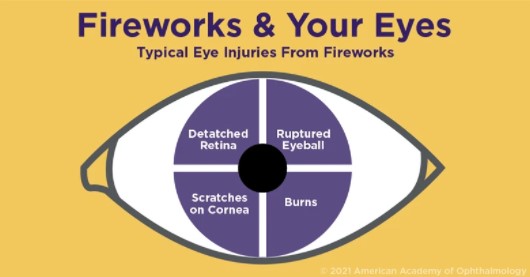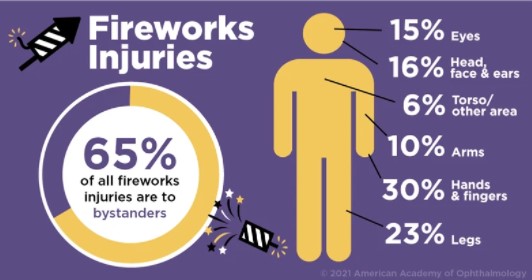Prior to the "booming" July holiday, June is recognized as Fireworks Eye Safety Month, and because fireworks sometimes become a part of many year-round celebrations, not only Independence Day, it is an excellent opportunity to clarify our understanding of the do’s and don'ts of pyrotechnic use. Eye injuries from fireworks can be especially severe because of the combination of force, heat and chemicals. Following a few simple safety tips can help make for a safe, fun celebration.
The most recent Consumer Product Safety Commission report found that 15% of fireworks injuries were eye injuries. In the most severe cases, fireworks can rupture the globe of the eye, cause chemical and thermal burns, corneal abrasions and retinal detachment — all of which can cause permanent eye damage and vision loss. Children and young adults are frequent victims of fireworks accidents and mishaps. Even sparklers can be dangerous and it's important to note that those injured by fireworks aren’t necessarily handling the explosives themselves. In fact, 65% of people injured by fireworks were bystanders, according to another study. Children and people not handling fireworks themselves are in as much danger as those lighting fireworks.
Prevent Blindness America and the American Academy of Blindness sponsor June as Fireworks Eye Safety Month to raise awareness of the dangers, as well as the safe protocols for viewing or handling pyrotechnic displays or devices. It is critical at the outset to understand that these devastating injuries are not restricted to large explosives but are often derived from seemingly innocent firework items. It is easy for any of us to get caught up in all the excitement and activity or become distracted by hosting responsibilities, conversations, and crowds. Take into consideration, as well, that these festivities and shows are generally conducted past dusk and simply navigating an event with numerous people and smoke bombs can become challenging, let alone successfully dodging the searing signatures of sparkler-wielding children.
While consumer fireworks are illegal in some places in the US, most states permit the sale and use of what are considered Safe and Sane items. Whether one supports the use or ban of consumer fireworks, it is important to practice and share firework safety guidelines. The American Academy of Ophthalmology recommends critical practices and procedures for firework use.
Fireworks safety tips
For those who decide to purchase consumer fireworks because they live in states where they are legal, the Academy recommends the following safety tips to prevent eye injuries:
- Never let young children play with fireworks of any type, even sparklers.
- People who handle fireworks should always wear protective eyewear that meets the parameters set by the American National Standards Institute and ensure that all bystanders are also wearing eye protection. Leave the lighting of professional-grade fireworks to trained pyrotechnician
What to do in the event of a fireworks eye injury
If an eye injury from fireworks occurs, remember:
- Seek medical attention immediately.
- Do not rub your eyes.
- Do not rinse your eyes.
- Do not apply pressure.
- Do not remove any objects that are stuck in the eye.
- Do not apply ointments or take any blood-thinning pain medications such as aspirin or ibuprofen
If you or a loved one has sustained an eye injury related to a fireworks display, seek medical attention immediately. Depending on the extent of the injury, the emergency team may recommend that you consult with your local eye doctor for continued care.
Additionally, the summer season is an excellent time of year to schedule a comprehensive eye exam with your eye doctor. With a more flexible schedule, it is probably easier to get you in to have your eyes thoroughly evaluated. Visit our website prior to scheduling your next eye exam to locate an optomap provider near you.

